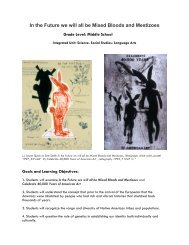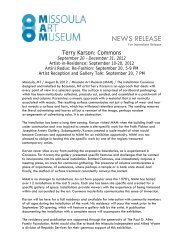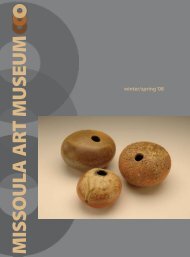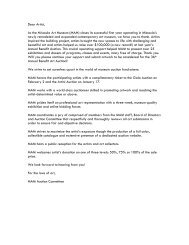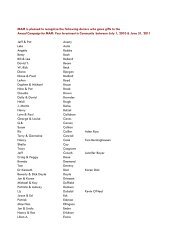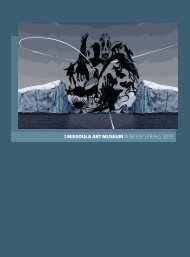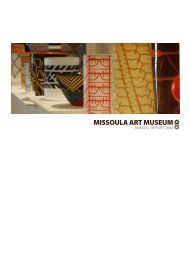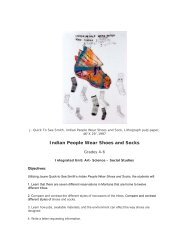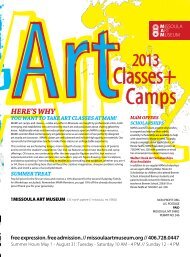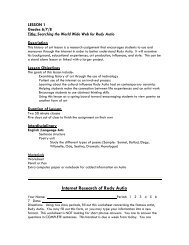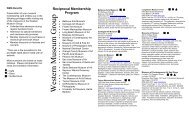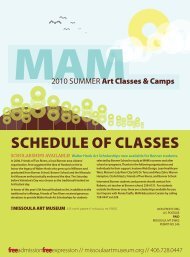Reading Into Rabbits - Missoula Art Museum
Reading Into Rabbits - Missoula Art Museum
Reading Into Rabbits - Missoula Art Museum
Create successful ePaper yourself
Turn your PDF publications into a flip-book with our unique Google optimized e-Paper software.
<strong>Reading</strong> into Rabbit<br />
8 th Grade <strong>Art</strong> Lesson<br />
Jennifer Ogden, 2008<br />
Description:<br />
Student will study two art pieces found in the <strong>Missoula</strong> <strong>Art</strong> <strong>Museum</strong> online<br />
collection by Jaune Quick-to-See Smith called, CELEBRATE 40,000 YEARS OF<br />
AMERICAN ART and IN THE FUTURE WE WILL ALL BE MIXED BLOODS AND<br />
MESTIZOES. )Images can be viewed on the MAM website.)<br />
Students will create a collage portrait of an animal they admire, adding additional<br />
personal information and imagery to the mix that speaks to the concept of<br />
mystery.<br />
Materials: Paper, pencil, polymer medium, stiff bristle paintbrush, scissors,<br />
tempera paint, magazines to cut up, patterned paper such as origami paper, oil<br />
pastel or chalk pastel.<br />
Duration:<br />
Six, one-hour sessions.<br />
Goals and Learning Objectives:<br />
Students will study two Coyote works from the online permanent collection,<br />
CELEBRATE 40,000 YEARS OF AMERICAN ART and IN THE FUTURE WE<br />
WILL ALL BE MIXED BLOODS AND MESTIZOES.<br />
Students will hypothesize possible meanings they find from the combination of<br />
symbols found in the artwork.<br />
Students will evaluate Smith’s use of imagery and how she partners with the<br />
viewer to explore message or meaning.<br />
Students will read a Salish Coyote story having to do with the origin of the Red<br />
and White Races. (Please keep in mind that there is protocol having to do with<br />
what time of year a story may be told. When snow is on the ground).<br />
Teacher Resources:<br />
www.missoulaartmuseum.org<br />
MAM's permanent online collection features a wide range of Jaune Quick-to-See<br />
Smith's work. Click on "experience", type in the artist's name for keyword search.<br />
The images to be used, as spurs for the following lesson are CELEBRATE<br />
40,000 YEARS OF AMERICAN ART and IN THE FUTURE WE WILL ALL BE<br />
MIXED BLOODS AND MESTIZOES. Click on descriptive lists, as well as<br />
images.
http://kemperartmuseum.wustl.edu/islandpress/html/keyIP105.html<br />
This helps us to learn a bit about Jaune Quick to See Smith’s thought process<br />
behind CELEBRATE 40,000 YEARS OF AMERICAN ART. Click on “associated<br />
pictures” for a look at the people who helped make the over large prints and for a<br />
human to print size ratio.<br />
http://www.tnellen.com/cybereng/lit_terms/allegory.html<br />
Definition for “Allegory”.<br />
http://members.cox.net/academia/coyote.html<br />
An informative website which offers wide ranging links to Coyote and other<br />
trickster characters from different regions and nations.<br />
http://www.turtletrack.org/Issues00/Co04222000/CO_04222000_Rabbitdanc<br />
e.htmCanku Ota is a newsletter that celebrates Native American heritage.<br />
This website takes us to a Mohawk legend telling about the origin of the<br />
Rabbit Dance.<br />
http://www.ucan-online.org/legends.asp<br />
An informative website from the Cherokee Nation which serves as a library for<br />
traditional stories from many Nations. Click on “Plateau Area”, scroll down to<br />
“Salish”, and then find “The Creation of the Red and White Races”.<br />
http://biology.about.com/library/weekly/aa100903a.htm<br />
A user-friendly tutorial about Gregor Mendel’s Law of Segregation<br />
Gregor Mendel: The Friar Who Grew Peas, by Cheryl Bardoe, illustrated by<br />
Joseph A. Smith (2006 The Field <strong>Museum</strong> and Abrahms Books for Young<br />
Readers, Harry N. Abrahms, Inc.).<br />
Vocabulary:<br />
Symbol- Something used for or representing something else. An emblem, token<br />
or sign.<br />
Petroglyph- An ancient image pecked or cut into a rock surface, not to be<br />
mistaken with Pictograph, which is an ancient image painted or drawn onto a<br />
rock surface.<br />
Allegory- A form of extended metaphor, in which objects, persons, and actions<br />
in a narrative, are equated with the meanings that lie outside the narrative itself.<br />
The underlying meaning has moral, social, religious, or political significance, and<br />
characters are often personifications of abstract ideas as charity, greed, or envy.<br />
Thus an allegory is a story with two meanings, a literal meaning and a symbolic<br />
meaning.
Juxtaposition- two unrelated objects placed next to each other for the purpose<br />
of contrast or comparison.<br />
Irony- the use of words or imagery combined in such a way as to convey a<br />
meaning unintended in their original and singular state.<br />
Mestizo- a person of mixed American Indian and European descent.<br />
Analogous Color- Colors adjacent to each other on the color wheel, such as<br />
orange, yellow-orange and yellow.<br />
Learning Sparks:<br />
Study the works, CELEBRATE 40,000 YEARS OF AMERICAN ART and IN<br />
THE FUTURE WE WILL ALL BE MIXED BLOODS AND MESTIZOES with the<br />
class. What clues are found in the imagery, quotes, titles of the pieces, and mood<br />
perceived on the whole by the viewer How do they compare and how do they<br />
differ What theme do they appear to hold in common What is the significance<br />
of the Rabbit figure What do you think are issues important to the artist<br />
It is appropriate for this lesson to relay quotes from the Kemper <strong>Art</strong> <strong>Museum</strong><br />
article (see teacher resources) where Jaune Quick–to-See Smith talks about her<br />
print; CELEBRATE 40,000 YEARS OF AMERICAN ART. In the article, Smith<br />
talks about her fascination with a petroglyph from the Canadian Shield region of<br />
Ontario, found near Stoney Lake near the town of Peterborough. An image which<br />
is apparently from the Upper Paleolithic time period dating 10,000 to 40,000<br />
years ago-PLENTY OLD! Paleo imagery of this estimated age is on par with the<br />
famous animal images at the caves in Lascaux, France. (Other sources,<br />
including the Canadian Peterborough Provincial Park website, relay that the<br />
images are dated at 900-1400 A.D.). A carving in the white limestone wall<br />
features an anthropomorphized rabbit figure standing on hind legs. Smith refers<br />
to Rabbit figures from other cultures worldwide, favoring the universality of the<br />
image that so resonated for her when she became aware of the image in the<br />
1970’s.<br />
A look into the traditional stories of the Algonquin tribe, which hails from the<br />
Peterborough region, suggests that the petroglyph is a Rabbit Spirit who is<br />
interested in helping humans communicate with the spirit world and teaches<br />
them ways to do this. In fact, local Native elders refer to the prodigiously<br />
inscribed rock walls of the Peterborough area as “the rocks that teach”. Among<br />
other American Indian tribes, Rabbit is like Coyote or Raven, something of a<br />
trickster. Upon first seeing Quick-to-See Smith’s image of the rabbit, you might<br />
immediately think of the familiar shape of the cartoon character, Bugs Bunny,<br />
who also shares some of the same penchant for playing tricks on his enemies<br />
and using humor while trying to survive hunting season.
What is striking about seeing CELEBRATE 40,000 YEARS OF AMERICAN ART<br />
in person is that it is large. Standing next to the looming black silhouette of the<br />
rabbit, who leads a line of five other rabbits who diminish in size the further back<br />
in line they go, is like regarding another human being right in front of you. The<br />
background of the print is gritty and drippy and quite textural, sort of like a rock or<br />
cave wall. It is evocative of the ancient origin of the Rabbit Spirit image. While<br />
looking through some leads on Rabbit stories I came across a few versions of a<br />
Mohawk legend called “The Rabbit Dance”, which tells of two hunters who are<br />
taught the steps and rhythm of a dance by a Rabbit Chief, who thumps his foot to<br />
assemble his tribe. They proceed to dance in a line, and then disappear. The<br />
hunters go home and relay this to their mother, who tells them to remember the<br />
rhythm made by the thumping of Rabbit Chief’s foot, and the steps made by the<br />
Rabbit tribe then teach them to the people in order to remember and honor<br />
rabbits in the future.<br />
Quick-to See Smith uses the rabbit image in her other artwork; IN THE FUTURE<br />
WE WILL ALL BE MIXED BLOODS AND MESTIZOES. A standing red rabbit<br />
figure, which appears to have flaps at his feet like a paper doll, is superimposed<br />
over scientific illustrations and writing which describe aspects of a theory brought<br />
forth in the 1860’s by Czechoslovakian monk and scientist, Gregor Mendel. A<br />
black silhouette which looks like it would fit onto the rabbit like a paper doll<br />
garment is shown in high contrast in the background of the image. Although the<br />
word “segregation” is one fraught with controversy, Mendel’s Theory of<br />
Segregation was intended as a scientific quest for a Universal Law and was<br />
created using green and yellow pea plants. Here Smith has shown red and white<br />
for the botanical illustrations in her artwork. Mendel’s work with peas was all<br />
about genetics, and how dominant and recessive genes can show up in plant<br />
breeding over successive generations. Plants bred to maintain their original<br />
features are considered homogenous, where plants with mixed features are<br />
considered heterogeneous.<br />
Clearly, Smith is speaking to the genetic mixing of people of different tribes, and<br />
races in her artwork. There are likely some strong feelings about such a notion<br />
as losing genetic purity, especially if it means losing touch with one’s bloodline<br />
and by extension full exposure to ones culture. A person from another country<br />
such as Denmark might just say that their parents are Danish and their<br />
grandparents are Danish and so on up the line. A typical mainstream American<br />
might list different nationalities in her genetic make-up, and proudly so. But<br />
mainstream America needs reminders of other worldviews among people right<br />
here on this continent. We are fortunate to have artists such as Jaune Quick-to-<br />
See Smith lend us her glasses, so we can try to see issues through her eyes.<br />
Smith has certain imagery that she uses repeatedly in her large body of work,<br />
such as horses, or rabbits or coyotes. She chooses them because they resonate<br />
to her personally, and they seem to be the correct language to suit her message
at the time. Many contemporary artists have a special affinity for certain animals,<br />
which appear time and again in their work.<br />
Steps and Procedures:<br />
Have your students think of an animal that they particularly admire. It can be one<br />
they have known personally, or one that they admire for its beauty, speed, grace,<br />
temperaments, etc.<br />
Begin by having the students work with a bit of text from the magazines. Think of<br />
adjectives that describe the animal you wish to honor and see if you can find<br />
those words in the magazines, if not, are there images you find that describe the<br />
animal Don’t let the students get too bogged down with the magazines, as<br />
trolling through them can be overly stimulating, time consuming and a good way<br />
to lose focus. Set aside a small pile of text material and when ready, begin to<br />
play with the composition on a piece of mat board or cardboard. Paste them<br />
down using a layer of polymer medium or glue, then the paper, then go over the<br />
top with a second layer to anchor it down.<br />
Add a thin, wash-like layer of paint, limiting the range of color. The idea is to<br />
allow important words or images to peak through, but be subordinate to the next<br />
layer. By limiting the students to two colors, they can explore the territory in<br />
between them by mixing them in differing amounts or create a textural white<br />
canvas by layering over with a thin white. At any rate, the color will be another<br />
subordinate layer for the animal image that will go on top.<br />
The student may portray the animal how they see it in their mind. It may be<br />
anthropomorphized or realistic or cartoon or stick figure, or a pastiche of physical<br />
features from magazines or patterned paper.<br />
A good creative spur is to look through some haiku or tanka poems that describe<br />
the animal in question or to have the students write one in honor of their animal,<br />
brief snapshots that help the student to think in a more sensory or emotional<br />
manner. This might solve the problem of getting bogged down in a random<br />
search for text trolling through magazines and of course their collage is the<br />
perfect place to paste down the words to the poem.<br />
Another creative spur is to do a web quest on the animal they chose and pay<br />
close attention to traditional stories that come from around the world. There might<br />
be some details that resonate and could be channeled into the collage.<br />
Assessment:<br />
The introductory material is a way for the teacher to go deep with the issues<br />
presented in the two works by Jaune Quick-to See Smith. I encourage the<br />
teacher to facilitate some research by the students and to see what kinds of<br />
animal stories they come up with. The artwork could be shown next to the story,<br />
whether original or traditional.



